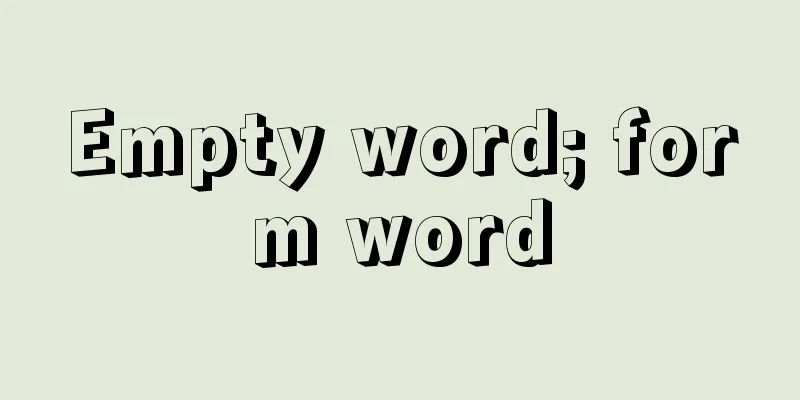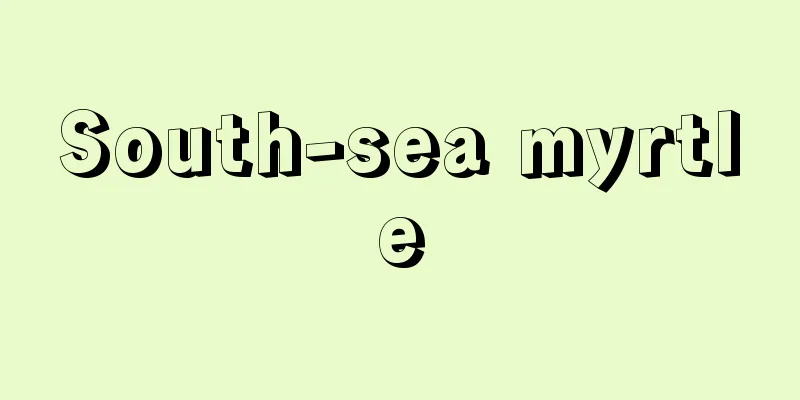Echigoya

|
Takatoshi, the founder of the wealthy Mitsui family, opened a kimono shop in Edo Nihonbashi Honcho 1-chome (Chuo Ward, Tokyo) in 1673 (Enpo 1). It is the predecessor of the current Mitsukoshi department store. Takatoshi's mother Shuho ran a pawnbroker and liquor store in Ise Matsusaka (Matsusaka City, Mie Prefecture). Takatoshi's grandfather Takayasu was called Echigo no Kami (Lord of Echigo), so the shop was called "Lord Echigo's Liquor Store," and so the Edo kimono shop was named "Echigoya." Initially, the store was 9 shaku wide and 11 ken deep. Takahira, the eldest son, and Takatomi, the second son, were in charge of the store, and the number of employees, including clerks, children, and servants, was less than 10. In 1683 (Tenwa 3), the company moved to Suruga-cho (current location of Mitsui Main Building), and while it had previously focused on selling on credit to samurai residences, it switched to targeting townspeople and commoners with a new business method of "selling at low prices on silver and no credit," and prospered greatly, becoming the largest kimono merchant of the Edo period. The company's prosperity is depicted in many nishiki-e prints, including Saikaku's "Eitaigura in Japan." In Edo, the company set up a purchasing store (with Takatomi and Takahira in the title), a cotton store (later renamed Mukodana, where Mitsukoshi is currently located) in addition to the main store (a kimono store), and a store in Shibaguchi. In 1691 (Genroku 4), the company opened a branch in Osaka, and expanded its collection network to a wide range of production areas to conduct business nationwide. On the other hand, they served as the shogunate's payment storehouse kimono supplier, and also operated a currency exchange shop, and in 1691 they became the purveyor of Osaka's silver treasury, becoming the largest purveyor to the government, and their kimono shop flourished. In 1713 (Shotoku 3), the number of employees at the main store (kimono shop) reached 350 in total: 44 clerks in Kyoto, 51 children, and 9 servants (total 104), 106 clerks in Edo, 44 children, and 35 servants (total 185), and 34 clerks in Osaka, 22 children, and 5 servants (total 61). During the late Edo period and the Meiji Restoration, the kimono industry fell into a slump, and with the advice of then Minister of Finance Inoue Kaoru, Councillor Okuma Shigenobu, and Minister of Finance Shibusawa Eiichi, the Mitsui family decided to focus their business on finance, so in 1872 (Meiji 5), Echigoya left the Mitsui Omotokata (the governing body for household management and business) and was transferred to the management of a group of five Renke families, and the trademark was decided. When the Commercial Code came into effect in 1893, the company was renamed Mitsui Gofukuten General Partnership, and in 1904 (Meiji 37), it left the Mitsui family and established Mitsukoshi Gofukuten Co., Ltd. In 1928 (Showa 3), it was renamed Mitsukoshi Co., Ltd., and has remained that way to this day. [Mitsui Reiko] "The 100 Years of Mitsui" by Yasunosuke Hoshino (1968, Kajima Institute Publishing)" ▽ "The 300 Years of Mitsukoshi Business Law" edited by Sanyu Newspaper (1972, Hyogensha)" ▽ "The 300 Years of Mitsukoshi Business Strategy" by Junjiro Takahashi (1972, Sankei Newspaper Publishing Bureau) [Reference items] | | | | |Source: Shogakukan Encyclopedia Nipponica About Encyclopedia Nipponica Information | Legend |
|
豪商三井家の家祖高利(たかとし)が1673年(延宝1)江戸日本橋本町一丁目(東京都中央区)に開いた呉服店。現在の三越(みつこし)百貨店の前身。高利の母殊法(しゅうほう)が伊勢(いせ)松坂(三重県松阪市)に質屋・酒屋を営み、祖父高安(たかやす)が越後守(えちごのかみ)と称したので、「越後殿の酒屋」とよばれたことにちなみ、江戸の呉服屋を「越後屋」と名づけた。最初、店の規模は間口9尺奥行11間。長男高平(たかひら)と次男高富(たかとみ)が店務にあたり、店員は手代・子供・下男あわせて10人足らずであった。1683年(天和3)駿河(するが)町(現三井本館の所在地)に移り、それまで武家屋敷相手の掛売りが主だったのを「現銀安売無掛値(かけねなし)」という新しい商法で、町人・庶民目当てに切り替えてから大いに繁栄、江戸時代最大の呉服商となった。その繁盛ぶりは多くの錦絵、西鶴(さいかく)の『日本永代蔵(えいたいぐら)』にも描かれた。京都に仕入店(しいれだな)を置き(高利と高平があたる)、江戸には本店(ほんだな)(呉服店)のほか綿店(わただな)(のち向店(むこうだな)と改称、現三越の所在地)、芝口(しばぐち)店を設け、1691年(元禄4)には大坂にも支店を開き、生産地には広く集荷網を張って全国的な商業を営んだ。他方、幕府払方御納戸(おなんど)呉服御用達(ごようたし)を勤め、両替店をも兼営、1691年大坂御金蔵銀御為替(おかねぐらぎんおかわせ)御用達の地位を得て、最大の御用商人となり、呉服店も繁盛した。1713年(正徳3)の本店(呉服店)店員数は、京都手代44、子供51、下男9の計104、江戸手代106、子供44、下男35の計185、大坂手代34、子供22、下男5の計61合計350人に達した。幕末・明治維新期は呉服業が不振に陥り、時の大蔵大輔(たいふ)井上馨(かおる)、参議大隈重信(おおくましげのぶ)、大蔵大丞(だいじょう)渋沢栄一らの勧告もあって、三井家事業の中心を金融に置くことになったので、1872年(明治5)、越後屋は三井大元方(おおもとかた)(家政・営業の統轄機関)を離れて連家(れんけ)(5軒)の経営に移され、商標をと定めた。1893年商法施行に際し、合名会社三井呉服店と改称、さらに1904年(明治37)三井家から離れて株式会社三越呉服店を設立。1928年(昭和3)株式会社三越と改めて現在に至る。 [三井礼子] 『星野靖之助著『三井百年』(1968・鹿島研究所出版)』▽『三友新聞社編『三越三百年の商法』(1972・評言社)』▽『高橋潤二郎著『三越三百年の経営戦略』(1972・サンケイ新聞出版局)』 [参照項目] | | | | |出典 小学館 日本大百科全書(ニッポニカ)日本大百科全書(ニッポニカ)について 情報 | 凡例 |
>>: Echigo Plain - Echigo Heiya
Recommend
rakṣas (English spelling)
...A demon in Hindu mythology. A transliteration ...
Pavol Josef Šafárik
1795‐1861 Slovak scholar and poet. In Czech, his n...
Pacific Community
The organization was established in 1947 after the...
Genetic grid method - Genetic grid method
…There are two methods for progeny testing of dai...
Kemeny Z. (English notation) KemenyZ
… After the defeat in the War of Independence (th...
Calico (cotton fabric) - Calico
…A type of plain-woven cotton fabric. A colloquia...
Pickled plums
〘Noun〙① Plums pickled in salt or shochu. They are ...
ektara (English spelling)
...Baul's poetic expression and musical value...
Cilacap (English spelling)
A port town in the middle of the south coast of Ja...
Domostroi (English spelling)
...The "Velikie Chet'i-Minei" (1552...
Hybrid language - Konseigengo (English spelling)
The word "hybridization" is often used i...
Nesting pillow - Ireko makura
Made in nest 1 Box pillow Hakomakura . Source: Abo...
Genroku Gold and Silver
After the unification of the Shogunate currency i...
Gaddafi
Libyan soldier and politician. Born to a nomad fam...
Family Composition
…Abandoning the speculative style of his predeces...








![Mino [town] - Mino](/upload/images/67ccf4d9474cb.webp)
